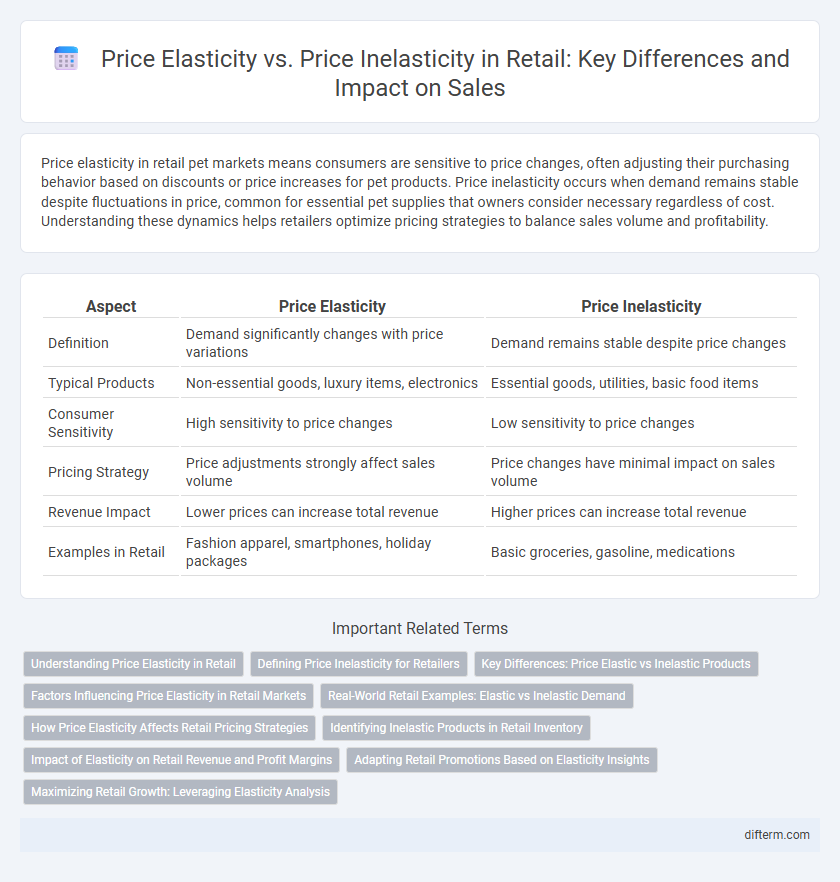Price elasticity in retail pet markets means consumers are sensitive to price changes, often adjusting their purchasing behavior based on discounts or price increases for pet products. Price inelasticity occurs when demand remains stable despite fluctuations in price, common for essential pet supplies that owners consider necessary regardless of cost. Understanding these dynamics helps retailers optimize pricing strategies to balance sales volume and profitability.
Table of Comparison
| Aspect | Price Elasticity | Price Inelasticity |
|---|---|---|
| Definition | Demand significantly changes with price variations | Demand remains stable despite price changes |
| Typical Products | Non-essential goods, luxury items, electronics | Essential goods, utilities, basic food items |
| Consumer Sensitivity | High sensitivity to price changes | Low sensitivity to price changes |
| Pricing Strategy | Price adjustments strongly affect sales volume | Price changes have minimal impact on sales volume |
| Revenue Impact | Lower prices can increase total revenue | Higher prices can increase total revenue |
| Examples in Retail | Fashion apparel, smartphones, holiday packages | Basic groceries, gasoline, medications |
Understanding Price Elasticity in Retail
Price elasticity in retail measures how sensitive consumer demand is to changes in product prices, indicating that a small price change can significantly impact sales volume for elastic products. Retailers use price elasticity to optimize pricing strategies, balancing competitive pricing with profitability by analyzing factors like product necessity, substitute availability, and consumer preferences. Understanding price elasticity helps retailers identify which products can tolerate price fluctuations and which require stable pricing to maintain customer loyalty and revenue.
Defining Price Inelasticity for Retailers
Price inelasticity in retail refers to a situation where changes in product prices result in minimal changes in consumer demand, indicating that customers continue purchasing despite price fluctuations. Essential for retailers, understanding price inelasticity allows them to adjust prices strategically without significantly affecting sales volume or revenue. Products with strong brand loyalty or essential goods typically exhibit price inelasticity, enabling retailers to maintain profitability even in competitive markets.
Key Differences: Price Elastic vs Inelastic Products
Price elastic products experience significant changes in demand when prices fluctuate, commonly seen in non-essential or luxury retail items such as fashion apparel and electronics. Price inelastic products maintain relatively stable demand despite price changes, often including essential goods like groceries and basic household items. Understanding these differences enables retailers to optimize pricing strategies, maximizing revenue while catering to consumer sensitivity.
Factors Influencing Price Elasticity in Retail Markets
Price elasticity in retail markets is heavily influenced by factors such as product necessity, availability of substitutes, and consumer income levels. Essential goods with few alternatives tend to exhibit price inelasticity, while luxury items and products with many substitutes demonstrate higher price elasticity. Brand loyalty and the time frame for adjusting purchase behavior also significantly impact how sensitive demand is to price changes.
Real-World Retail Examples: Elastic vs Inelastic Demand
In retail, price elasticity is evident in products like clothing and electronics, where consumers often respond quickly to price changes by switching brands or delaying purchases. Conversely, price inelasticity occurs with essential goods such as groceries and prescription medications, where demand remains stable despite price fluctuations. Retailers use this understanding to strategically price luxury items versus everyday necessities, maximizing revenue and customer retention.
How Price Elasticity Affects Retail Pricing Strategies
Price elasticity significantly influences retail pricing strategies by determining how sensitive consumers are to price changes in products. Retailers adjust prices strategically for elastic goods, where small price shifts lead to substantial changes in demand, often using promotions and discounts to boost sales volume. In contrast, inelastic products allow retailers to maintain stable prices with minimal impact on demand, optimizing profit margins by focusing less on price competition.
Identifying Inelastic Products in Retail Inventory
Identifying inelastic products in retail inventory involves analyzing items with minimal demand fluctuation despite price changes, such as essential groceries, medications, and basic household goods. These products exhibit low price elasticity, meaning consumers continue purchasing them regardless of price increases or decreases, which helps retailers maintain stable revenue streams. Focusing on inventory with high inelasticity enables optimized pricing strategies and inventory management to maximize profitability during market volatility.
Impact of Elasticity on Retail Revenue and Profit Margins
Price elasticity directly influences retail revenue by determining how sensitive consumer demand is to price changes, where higher elasticity results in significant sales fluctuations with minor price adjustments. Price inelasticity allows retailers to increase prices without substantially reducing demand, thereby enhancing profit margins and stabilizing revenue streams. Understanding the degree of elasticity for specific products enables retailers to strategically set prices, optimize inventory turnover, and maximize overall profitability.
Adapting Retail Promotions Based on Elasticity Insights
Retailers optimize promotional strategies by analyzing price elasticity to determine how sensitive customers are to price changes. Products with high price elasticity respond well to discounts and sales, driving significant volume increases, while inelastic products maintain stable demand regardless of price shifts. Tailoring promotions based on elasticity insights maximizes revenue and inventory turnover by aligning marketing efforts with consumer purchasing behavior.
Maximizing Retail Growth: Leveraging Elasticity Analysis
Maximizing retail growth requires understanding price elasticity, which measures consumer responsiveness to price changes, enabling retailers to adjust prices strategically to boost sales and profits. Products with high price elasticity benefit from targeted promotions and discounts that stimulate demand, while items with price inelasticity maintain stable revenue despite price fluctuations due to essential or brand-loyal characteristics. Leveraging elasticity analysis allows retailers to optimize pricing strategies, inventory management, and marketing efforts to enhance profitability and market share.
Price Elasticity vs Price Inelasticity Infographic

 difterm.com
difterm.com